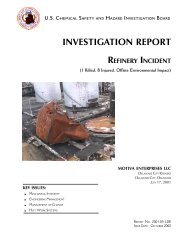CTA Report, Draft 1, ISP Review - US Chemical Safety and Hazard ...
CTA Report, Draft 1, ISP Review - US Chemical Safety and Hazard ...
CTA Report, Draft 1, ISP Review - US Chemical Safety and Hazard ...
Create successful ePaper yourself
Turn your PDF publications into a flip-book with our unique Google optimized e-Paper software.
6.0 Underst<strong>and</strong>ing Combustible Dust <strong>Hazard</strong>s<br />
6.1 Introduction<br />
Most organic materials <strong>and</strong> many metals—<strong>and</strong> even some nonmetallic inorganic materials, if finely<br />
divided <strong>and</strong> dispersed in suitable concentrations—will burn or explode if they contact a sufficient ignition<br />
source. 13 Not all small particles burn, however. For example, salt <strong>and</strong> baking soda, no matter how finely<br />
powdered, will not burn because they contain no combustible material. Coffee creamer, on the other<br />
h<strong>and</strong>, will burn because it contains fat (organic material). Materials that are capable of burning in air are<br />
called combustible materials.<br />
Combustible dusts can be generated when solid combustible materials are h<strong>and</strong>led or processed due to<br />
gradual reductions in the particle sizes <strong>and</strong>/or segregation of the particles. They are defined by NFPA 654<br />
(2000) (Table 1, see page 48) as any finely divided solid material 420 microns or less in diameter that<br />
presents a fire or explosion hazard when dispersed <strong>and</strong> ignited in air. The combustibility of dust is<br />
established through materials testing (FM Global, 2004). Awareness of combustible dust hazards is<br />
important to ensure employee safety, to ensure proper facility design, <strong>and</strong> to develop adequate operations<br />
<strong>and</strong> maintenance procedures.<br />
6.2 Dust Fire <strong>and</strong> Explosion <strong>Hazard</strong> Characteristics<br />
Like all other fires, a dust fire occurs when fuel (the combustible dust) comes in contact with heat (an<br />
ignition source) in the presence of oxygen (air). Removing any one of these elements of the fire triangle<br />
eliminates the possibility of a fire. A dust explosion requires the simultaneous presence of two additional<br />
13 Ignitability <strong>and</strong> Explosibility of Dusts, Table A.1, Appendix A.2 (Eckhoff, 2003).<br />
45









